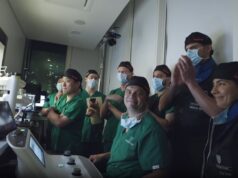
The existing body of evidence supporting artificial intelligence (AI) and the autonomous navigation of endovascular procedures is “inadequate”, despite the theoretical benefits held by this “promising” concept.
This is among the concluding messages delivered by Thomas Booth (Kings College Hospital, London, UK) and his research team following a systematic review of the recent literature in this sphere—findings from which are now published in Frontiers in Human Neuroscience.
“The concept of fully autonomous navigation in endovascular interventions is promising; however, with a TRL [technology readiness level] of 3, the technology is yet to complete validation even in a laboratory environment,” Booth et al state.
“Due to the inadequate evidence supporting its use—the limited number of studies and its low level—it is far from being used in clinical practice. It first must be demonstrated that it can reliably provide benefits over currently available treatments before it can progress toward clinical trials.”
Decreased operation times, improved decision-making during surgery, and reduced operator radiation exposure, as well as an increased access to treatments like mechanical thrombectomy, are among the potential advantages of the autonomous navigation of catheters and guidewires in endovascular interventional surgery, Booth and colleagues initially posit. They further note that, if proven to be safe and effective in clinical trials, the benefits of autonomous navigation are “numerous”. The technology’s ability to offset the need for expertise in specialties currently facing skilled-operator shortages, and the fact it is not limited by human factors like fatigue and loss of focus, are additional positives highlighted by the authors.
In an effort to assess how close these theoretical benefits are to being realised, the research team searched PubMed and IEEEXplore databases to identify reports of AI applied to autonomous navigation methods in endovascular surgery. Following preferred reporting items for systematic reviews and meta-analysis (PRISMA) evaluations, eligible articles were assessed using quality assessment of diagnostic accuracy studies 2 (QUADAS-2).
A total of 14 studies were included for analysis—within which the data-driven models used for autonomous navigation consisted of reinforcement learning (64%) and/or learning from expert demonstration (50%). Reinforcement learning proved to have been a particularly popular methodology in recent years, the authors add, with the majority of studies (80%) published beyond 2018 utilising it.
The included studies conducted evaluations on either physical phantoms (71%) or in-silico models (29%). Experiments within or around the blood vessels of the heart were included in 10 of the 14 studies, while non-anatomical vessel platforms “idealised” for simple navigation were used in three studies and the porcine liver venous system was utilised in one.
“We observed that risks of bias and poor generalisability were present across all studies,” the authors write. “No procedures were performed on patients in any of the studies reviewed. Moreover, all studies were limited due to the lack of selection criteria, reference standards, and reproducibility, which resulted in a low level of evidence for clinical translation.”
The authors go on to stress that there is “no high-level evidence” demonstrating that AI-based, autonomous navigation of catheters and guidewires in endovascular intervention is non-inferior or superior to manual procedures—adding that such technologies are yet to surpass TRL 3 owing to no clinical validation nor comprehensive laboratory validation having been published to date.
“There are no standardised in-silico, in-vitro or ex-vivo experimental reference standard designs, nor are there standardised performance measures, meaning comparison of studies quantitatively is of limited value,” the research team continue.
However, outlining the main strength held by the studies they analysed, the authors note that a range of machine-learning techniques were employed, with the majority focusing on identifying an entirely new machine-learning technique that would improve on previous efforts rather than using previously published algorithms and applying them to “extending the experimental environment”. Exploring various approaches, they further state, is advantageous for research, “especially in the rapidly evolving field of machine learning”, as the fast pace of development increases the likelihood that more effective algorithms are created.
“Although it is plausible that autonomous navigation may eventually benefit patients while reducing occupational hazards for staff, there is currently no high-level evidence to support this assertion,” the authors add, also emphasising once again that the field is currently at an experimental, proof-of-concept stage.
“For the technology to progress, reference standards and minimum reporting standards need to be established to allow meaningful comparisons of new system development,” Booth et al conclude, further pointing to “clear regulation” as a key requirement moving forward.










